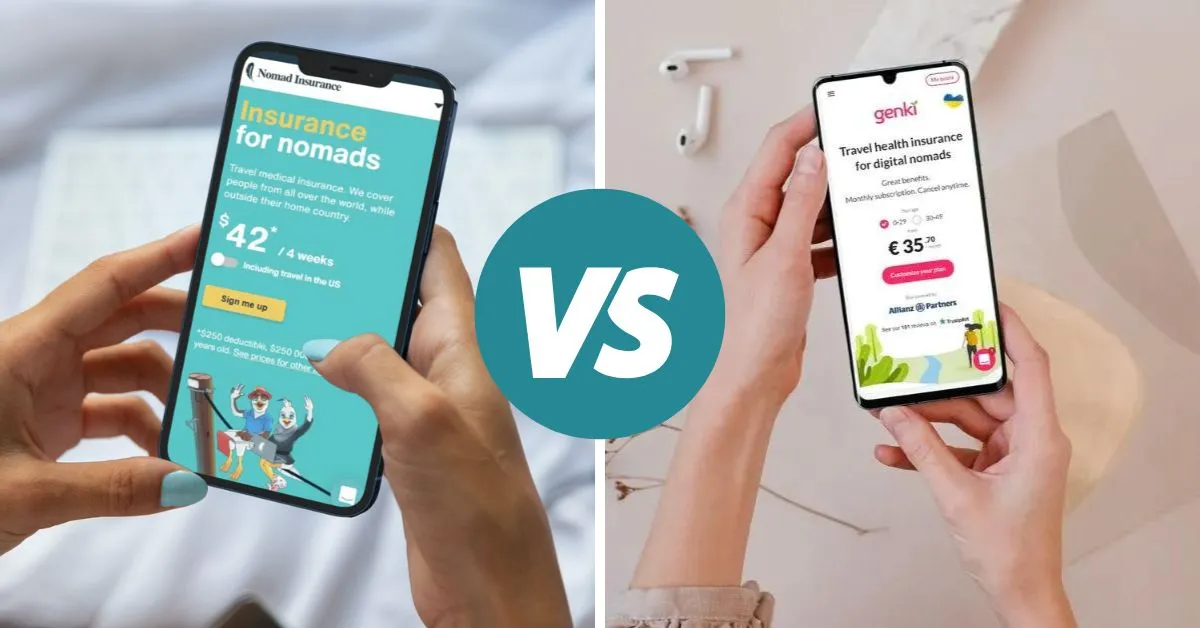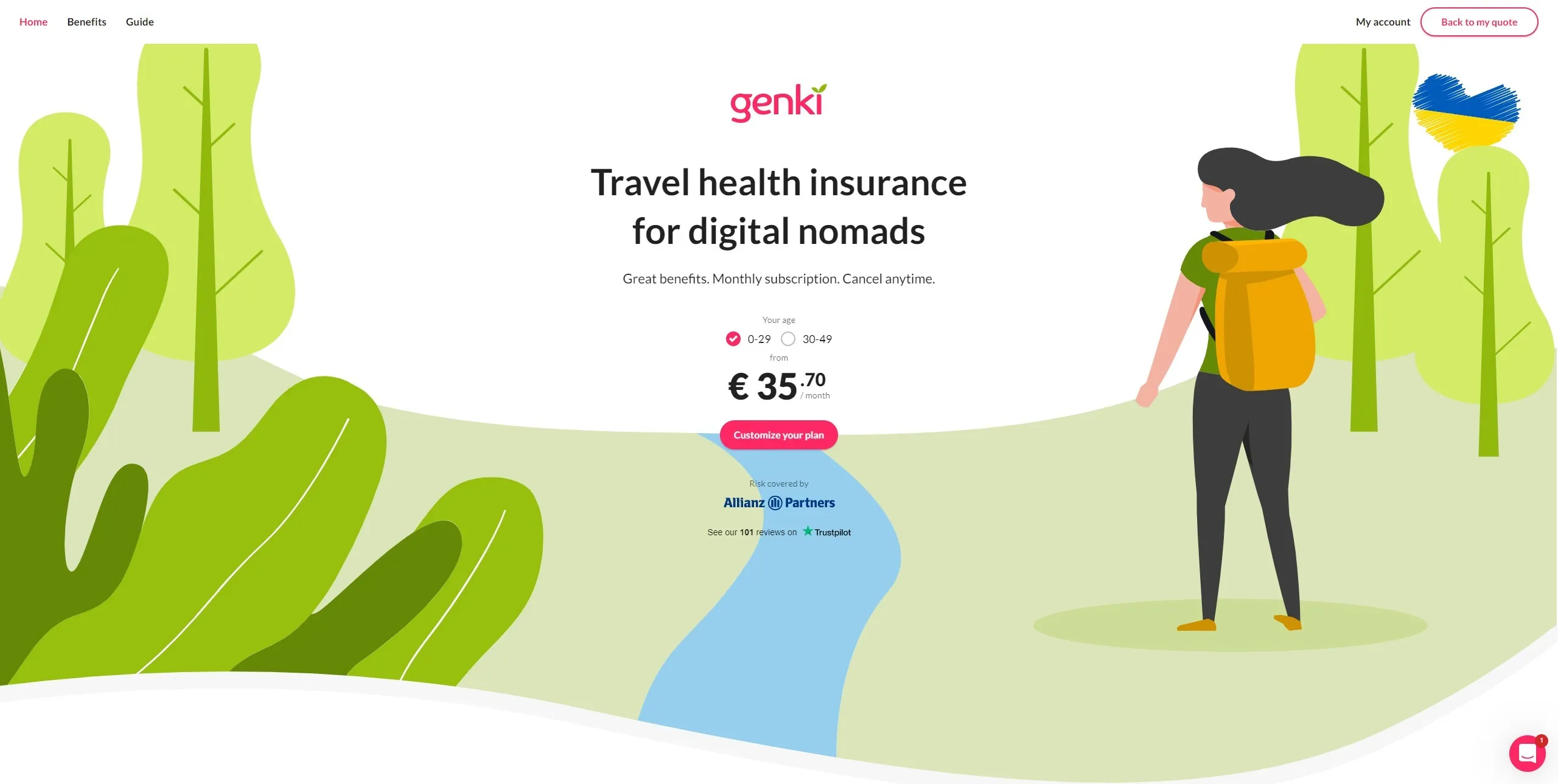When it comes to selecting the best insurance, it can be a tough call between SafetyWing and Genki.
Both offer top-notch coverage, but it’s important to make sure you get the right coverage for your needs.
So let’s have a look at both companies and see which insurance provider suits you better.

What Is SafetyWing?
SafetyWing is a travel insurance provider that offers comprehensive coverage for travelers. They are known for their Nomad Insurance product.
If you wish to learn more about this insurance, read our SafetyWing review.
Who Is SafetyWing For?
SafetyWing is ideal for travelers up to 69 years old.
It’s a great option for:
- Backpackers
- Digital nomads
- Expats
- Long-term travelers
- Short-term travelers
- Travelers who are already abroad
What Is Genki?
Genki provides health insurance for long-term travelers. You’ll get coverage from one month up to two years with a monthly subscription that you can cancel anytime.
If you wish to learn more about this insurance, read our Genki review.
Who Is Genki For?
Genki covers travelers up to 49 years old.
It’s a great option for:
- Backpackers
- Digital nomads
- Expats
- Long-term travelers
- Short-term travelers
- Travelers who are already abroad
SafetyWing Vs Genki: Overview
As you can see, so far, both providers seem to be targeting a similar customer base. Let’s dive deeper into their main differences.
We’ll compare their coverage, destinations, pricing, and payment plans. Keep reading to learn more.
SafetyWing Vs Genki: Coverage
When it comes to coverage, SafetyWing offers wider coverage. For example, SafetyWing covers travel mishaps like lost luggage, travel delays, etc. Genki is more of a health insurance provider and won’t deal with travel issues like those.
SafetyWing covers:
- Max Limit: $250,000 ($100,000 for 65 years and above)
- Deductible: $250
- Hospital: Room and nursing services
- Intensive care: Up to the overall maximum limit
- Ambulance: Usual, reasonable, and customary charges when covered illness or injury results in hospitalization
- Urgent charges: $50 co-payment, not subject to the deductible.
- Physical therapy and chiropractic care: Up to $50 per day. Must be ordered in advance by a physician.
- Emergency dental: Up to $1,000. Not subject to the deductible.
- All Other Eligible Medical Expenses: Up to the overall maximum limit.
- Notable exclusions: High-risk sports activity, pre-existing disease or injury, cancer treatment
- Trip interruption: Up to $5,000. No deductible
- Travel delay: Up to $100 a day after a 12-hour delay period requiring an unplanned overnight stay. Subject to a maximum of 2 days. No deductible
- Lost checked luggage: Up to $3,000 per certificate period; $500 per item. Up to $6,000-lifetime limit. No deductible.
- Natural disaster — a new place to stay: Up to $100 a day for 5 days. No deductible
- Political evacuation: Up to $10,000 lifetime maximum. Not subject to deductible
- Emergency medical evacuation: Up to $100,000 lifetime maximum. Not subject to deductible or overall maximum limit.
Genki covers:
- Medical treatment everywhere
- Covid-19
- Sports injuries for sports that are not excluded under dangerous activities
- Assistance and direct billing
- Hospital visits
- Medical transport
- Repatriation
- Pregnancy
- Emergency dental treatment
- Initial mental issue treatment
- Medication and materials
As you can see, Genki is more of a medical insurance than a travel insurance. But, depending on your needs, it might be a better fit.
Now let’s see where you are covered.
SafetyWing Vs Genki: Destinations
Genki offers coverage everywhere in the world, while SafetyWing has a few exclusions.
Let’s take a look at the destination covered by both providers.
SafetyWing covers you almost everywhere. You are only excluded from coverage if you travel to Cuba, Iran, Syria, and North Korea.
They have two main plans:
- Excluding travel in the United States
- Including travel in the United States
Genki covers you everywhere if you want to.
They have two main plans:
- Worldwide
- Worldwide excluding Canada and the USA
SafetyWing Vs Genki: Price
When it comes to prices, SafetyWing and Genki are both affordable. The main differences depend on your age, and plan chosen.
Let’s take a look at the plans offered by SafetyWing.
Nomad Insurance Cost (excluding travel in the United States):
- 15 days-9 years old: included in the price of an adult insurance
- 10-39 years old: $45.08 per 4 weeks
- 40-49 years old: $73.92 per 4 weeks
- 50-59 years old: $115.92 per 4 weeks
- 60-69 years old: $157.36 per 4 weeks
Nomad Insurance Cost (including travel in the United States):
- 15 days-9 years old: included in the price of an adult insurance
- 10-39 years old: $83.44 per 4 weeks
- 40-49 years old: $137.48 per 4 weeks
- 50-59 years old: $226.24 per 4 weeks
- 60-69 years old: $308.84 per 4 weeks
Now, let’s take a look at the plans offered by Genki.
Here’s the price per month if you’re between 0-29 years old:
- Worldwide (excluding Canada and the USA) with a €50 deductible: €35.70
- Worldwide with a €50 deductible: €72.30
- Worldwide (excluding Canada and the USA) with no deductible: €45
- Worldwide with no deductible: €83.10
Here’s the price per month if you’re between 30-49 years old:
- Worldwide (excluding Canada and the USA) with a €50 deductible: €54.60
- Worldwide with a €50 deductible: €108.60
- Worldwide (excluding Canada and the USA) with no deductible: €65.10
- Worldwide with no deductible: €128.70
As you can see, the coverage, age, and plan chosen can influence the price. In both cases, you’ll find affordable options, though.
SafetyWing Vs Genki: Payments
Both providers have automatic monthly payments. The main difference resides in when these monthly payments happen.
SafetyWing charges you every 4 weeks, while Genki charges you on the same day once per month. It might seem subtle, but in the end, you’ll have more payments with SafetyWing than Genki.
Does this mean it’s more expensive? Not necessarily. It depends on the length of your trip and the insurance chosen. We suggest you calculate both options to see which is the cheapest option.
Main Differences Between SafetyWing And Genki
Both insurances are great, but there are still a few differences worth looking at.
- Price: Genki is more affordable, but only if you’re less than 29 years old. Once you’re more than 30 years old, SafetyWing becomes cheaper.
- Coverage: Genki can cover you everywhere in the world, while SafetyWing has a few exceptions, like Cuba, Iran, Syria, and North Korea.
- Deductible: Genki offers a €50 deductible on its plans and a no-deductible plan, while SafetyWing has a deductible of $250.
- Automatic monthly payments: Genki charges you on the same day each month, while SafetyWing charges you every 28 days, resulting in 13 times per year instead of 12 times per year. That said, you may want to add the sums up to see which one is cheaper.
- Travel coverage: Genki covers medical issues but doesn’t cover travel delays, trip interruptions, or luggage issues. SafeyWing offers travel coverage too.
Now, these differences can influence your decision. Keep reading to learn how to decide which insurance is right for you.
How To Pick Which Insurance Is Best For You
When it comes to picking the right insurance, you need to consider your travel habits and needs. Here are a few questions you can ask yourself to make the right decision:
- Where are you traveling?
- How old are you?
- What type of coverage is essential to you? Medical, travel, or both?
- Is having a low deductible important to you?
- Do you want to save money and get the most affordable option?
Answering these questions will help you decide which insurance is best for you.
Final Thoughts On Genki Vs SafetyWing
Genki and SafetyWing are two great travel insurance options. Both offer affordable plans that can fit any need.
When it comes to pricing, Genki is more affordable for younger travelers. On the other hand, SafetyWing is more suitable for older people and those who want travel coverage included in the insurance.
Finally, SafetyWing charges you every 4 weeks, while Genki charges you once per month. We suggest calculating both options to see which one is cheaper.
In the end, the choice boils down to your personal needs and travel habits.
Traveling soon? Read one of the following guides:




